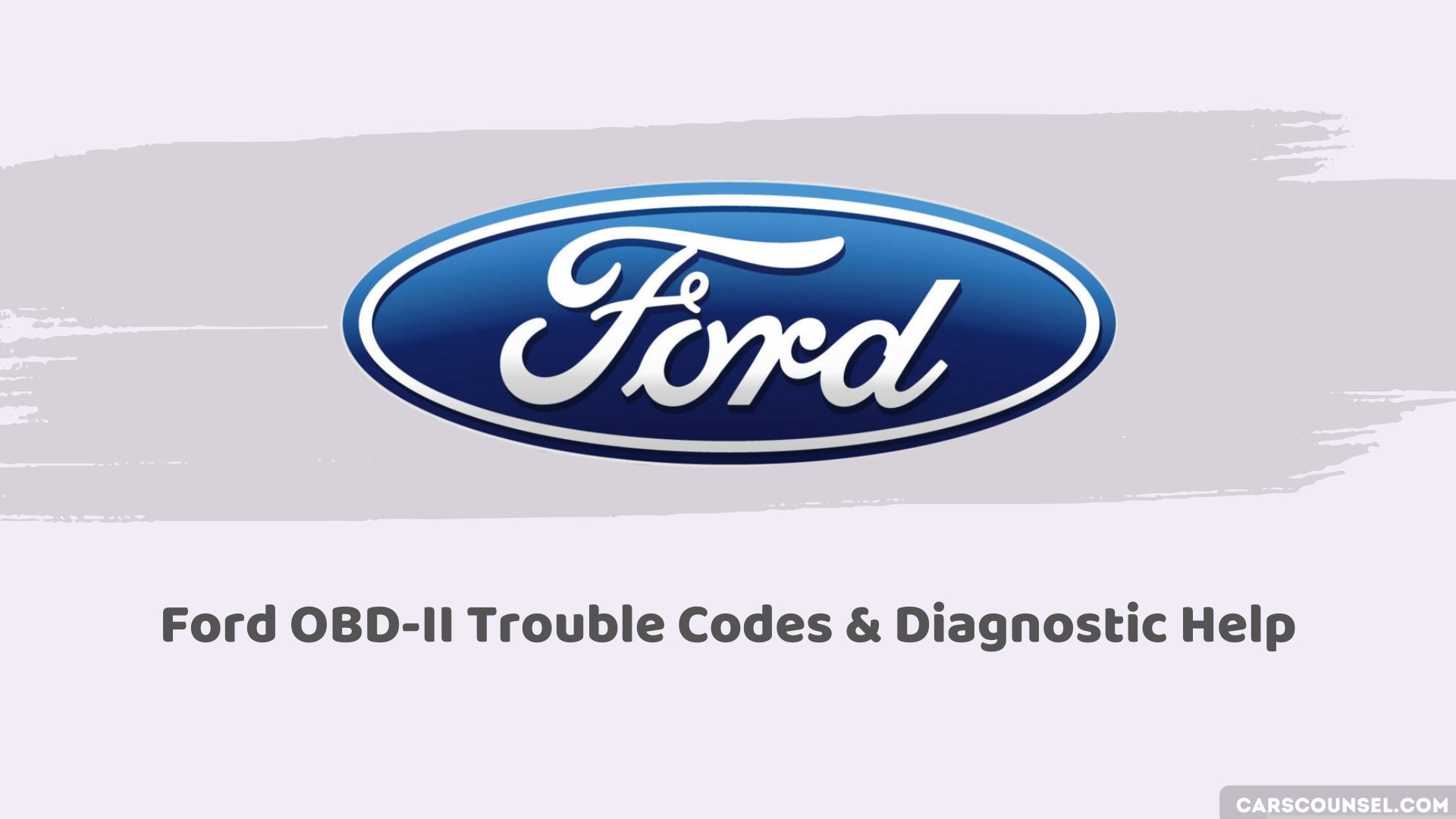When you notice your Ford’s “check engine” light is on, you’re likely wondering what’s going on under the hood. That’s where Ford OBD-II codes come in – a five-digit code that holds the key to identifying the specific issue plaguing your vehicle. But what do these codes mean, and how can you use them to pinpoint the problem?
You’re about to find out. With a basic understanding of Ford OBD-II codes, you’ll be able to diagnose and potentially fix the issue yourself, saving time and money in the process. But first, let’s break down what these codes are telling you.

Quick Navigation
Understanding Ford OBD-II Codes
When you encounter an issue with your Ford vehicle, the first step in diagnosing the problem is to understand the Ford OBD-II codes.
These codes are part of the self-diagnostic system in all Ford cars, indicating specific component issues with a five-digit code that can be read using an OBD-II scanner.
You can search for codes by P, B, C, or U codes, each related to a specific system or circuit.
The first number in the DTC indicates if the code is manufacturer-specific or generic, while the last three numbers provide specific information on the troubled vehicle system or circuit.
Understanding Ford OBD-II codes is essential for diagnosing and repairing issues in Ford vehicles.
Common Ford Fault Codes Explained
Since you’ve familiarized yourself with the structure of Ford OBD-II codes, it’s essential to understand what the most common fault codes mean.
You’ll often encounter Diagnostic Trouble Codes (DTCs) like P0101, P0300, or P0420, which indicate specific problems with your vehicle. These Trouble Codes can trigger the Check Engine light to illuminate, signaling that there’s an issue that needs attention.
For instance, P0101 might indicate a mass airflow sensor circuit malfunction, while P0300 could signify a random misfire detected. Understanding these codes helps you identify the root cause of the problem, allowing you to address it efficiently.
Advanced Diagnostics and Repairs
Delving into complex issues with your Ford vehicle requires advanced diagnostic tools and techniques to pinpoint the source of problems efficiently.
If you’re not equipped to handle intricate fault codes, consider consulting a professional mechanic or Ford dealership. However, if you’re up for the challenge, invest in advanced auto repair tools like the ANCEL FD700 to diagnose and address complex issues.
Use a scan tool to read and clear codes, and then test drive the vehicle to verify the issue is resolved. By empowering yourself with advanced diagnostic tools and techniques, you’ll be able to tackle intricate fault codes and guarantee peak vehicle performance, staying up-to-date with the latest Ford repair service expectations and recommendations.
Most Common Ford OBD-II Trouble Codes
| Code | Description |
|---|---|
| P0001 | Fuel Volume Regulator Control Circuit / Open |
| P0002 | Fuel Volume Regulator Control Circuit Range / Performance |
| P0003 | Fuel Volume Regulator Control Circuit Low |
| P0004 | Fuel Volume Regulator Control Circuit High |
| P0005 | Fuel Shutoff Valve ‘A’ Control Circuit / Open |
| P0006 | Fuel Shutoff Valve ‘A’ Control Circuit Low |
| P0007 | Fuel Shutoff Valve ‘A’ Control Circuit High |
| P0100 | Mass or Volume Air Flow Sensor ‘A’ Circuit |
| P0101 | Mass or Volume Air Flow Sensor ‘A’ Circuit Range/Performance |
| P0102 | Mass Air Flow (MAF) Circuit Low Input |
| P0103 | Mass Air Flow (MAF) Circuit High Input |
| P0106 | Barometric Pressure Sensor Circuit in within limits |
| P0107 | BARO/MAP Sensor Low Voltage |
| P0108 | BARO/MAP Sensor High Voltage |
| P0109 | BARO/MAP Sensor Circuit Intermittent |
| P0112 | Intake Air Temperature (IAT) Circuit Low Input |
| P0113 | Intake Air Temperature (IAT) Circuit High Input |
| P0116 | Engine Coolant Temperature Circuit Range/Performance Failure |
| P0117 | Engine Coolant Temperature (ECT) Circuit Low Input |
| P0118 | Engine Coolant Temperature (ECT) Circuit High Input |
| P0121 | Throttle Position (TP) Circuit Performance Problem |
| P0122 | Throttle Position (TP) Circuit Low Input |
| P0123 | Throttle Position (TP) Circuit High Input |
| P0125 | Insufficient Coolant Temperature For Closed Loop Fuel Control |
| P0127 | Intake Air Temperature Too High |
| P0131 | HO2S Sensor Circuit Out of Range Low Voltage (HO2S-11) |
| P0133 | HO2S Sensor Circuit Slow Response (HO2S-11) |
| P0135 | HO2S Sensor Circuit Malfunction (HO2S-11) |
| P0136 | HO2S Sensor Circuit Malfunction (HO2S-12) |
| P0141 | HO2S Sensor Circuit Malfunction (HO2S-125) |
| P0148 | Fuel Delivery Error |
| P0151 | HO2S Sensor Circuit Out of Range Low Voltage (HO2S-21) |
| P0153 | HO2S Sensor Circuit Slow Response (HO2S-21) |
| P0155 | HO2S Sensor Circuit Malfunction (HO2S-21) |
| P0156 | HO2S Sensor Circuit Malfunction (HO2S-22) |
| P0161 | HO2S Sensor Circuit Malfunction (HO2S-22) |
| P0171 | System to Lean (Bank 1) |
| P0172 | System to Rich (Bank 1) |
| P0174 | System to Lean (Bank 2) |
| P0175 | System to Rich (Bank 2) |
| P0176 | Flexible Fuel (FF) Sensor Circuit Malfunction |
| P0180 | Engine Fuel Temperature Sensor A Circuit Low Input (EFT) |
| P0181 | Engine Fuel Temperature Sensor A Circuit Range/ Performance (EFT) |
| P0182 | Engine Fuel Temperature Sensor A Circuit Low Input (EFT) |
| P0183 | Engine Fuel Temperature Sensor A Circuit High Input (EFT) |
| P0186 | Engine Fuel Temperature Sensor B Circuit Range/Performance (EFT) |
| P0187 | Engine Fuel Temperature Sensor B Circuit Low Input (EFT) |
| P0188 | Engine Fuel Temperature Sensor B Circuit High Input (EFT) |
| P0190 | Fuel Rail Pressure Sensor Circuit Malfunction (FRP) |
| P0191 | Fuel Rail Pressure Sensor Circuit Performance (FRP) |
| P0192 | Fuel Rail Pressure Sensor Circuit Low Input (FRP) |
| P0193 | Fuel Rail Pressure Sensor Circuit High Input (FRP) |
| P0201-P0212 | Cylinder #1 through Cylinder #12 Injector Circuits |
| P0217 | Engine Coolant Over-Temperature Condition |
| P0230 | Fuel Pump Primary Circuit Malfunction |
| P0231 | Fuel Pump Secondary Circuit Low |
| P0232 | Fuel Pump Secondary Circuit High |
| P0234 | Supercharger Overboost Condition |
| P0243 | Supercharger (Boost) Bypass Solenoid Circuit Malfunction |
| P0298 | Engine Oil Over Temperature Condition |
| P0300 | Random Misfire |
| P0301-P0310 | Misfire Detection Monitor (Cylinder specific) |
| P0320 | Ignition Engine Speed Input Circuit Malfunction |
| P0325 | Knock Sensor 1 Circuit Malfunction (Bank 1) |
| P0326 | Knock Sensor 1 Circuit Range/ Performance (Bank 1) |
| P0330 | Knock Sensor 2 Circuit Malfunction (Bank 2) |
| P0331 | Knock Sensor 2 Circuit Range/performance (Bank 2) |
| P0340 | Camshaft Position (CMP) Sensor Circuit Malfunction |
| P0350 | Ignition Coil (Undetermined) Primary/ Secondary Circuit Malfunction |
| P0351-P0360 | Ignition Coil A through J Primary/ Secondary Circuit Malfunction |
| P0400 | EGR Flow Failure |


How to clear “historic fault”.